Viele Blogger beginnen ihre Reise mit Blogger, weil es eine kostenlose und unkomplizierte Plattform ist. Wenn Ihr Blog jedoch wächst, könnten Sie sich durch die begrenzten Funktionen eingeschränkt fühlen.
Die Umstellung auf WordPress kann mit seinen umfangreichen Berechtigungen eine Welt der Möglichkeiten eröffnen. Aber es gibt eine häufige Sorge bei diesem Wechsel: der mögliche Verlust von Google-Rankings.
Dieser Artikel wird Sie durch den Übergang von Blogger zu WordPress führen. Wir werden uns darauf konzentrieren, wie Sie es richtig machen und sicherstellen, dass Sie Ihre wertvollen Google-Rankings intakt halten.
Unser Ziel ist es, Ihnen beim Upgrade Ihrer Blogging-Plattform zu helfen, ohne die SEO-Bemühungen zu opfern, die Sie bereits in Ihre Website gesteckt haben.
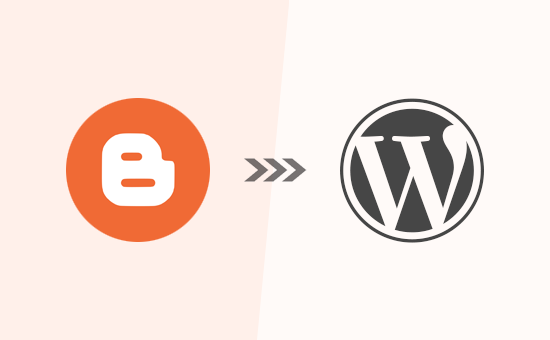
Warum von Blogger zu WordPress wechseln?
Blogger ist eine beliebte Blogging-Plattform, die von Google entwickelt wurde. Hier kann jeder mit seinem Google-Konto ein kostenloses Blog erstellen.
Viele Anfänger stellen jedoch schnell fest, dass sie mit ihrem kostenlosen Blogger-Blog nur sehr eingeschränkt arbeiten können.
Mit WordPress hingegen haben Sie die volle Kontrolle über Ihre Website. Außerdem können Sie die notwendigen Funktionen hinzufügen, um Ihren Blog zu erweitern und Ihre Inhalte zu vermarkten. Außerdem können Sie alle SEO-Optimierungen durchführen, um eine bessere Platzierung zu erreichen. Wir haben eine detaillierte Gegenüberstellung von WordPress und Blogger erstellt.
Wenn wir von WordPress sprechen, meinen wir das selbst gehostete WordPress.org, das NICHT mit WordPress.com verwechselt werden sollte, einer gehosteten Lösung, die ihre eigenen Einschränkungen hat. Einzelheiten finden Sie in unserem Artikel über den Unterschied zwischen WordPress.com und WordPress.org.
WordPress.org ist die beliebte „WordPress“-Plattform, von der Sie wahrscheinlich schon gehört haben, weil sie 43 % aller Websites im Internet betreibt.
Schauen wir uns also an, wie man richtig von Blogger zu WordPress wechselt und dabei die Google-Suchergebnisse und den Website-Traffic beibehält.
Hier sind die Schritte, die wir verwenden werden, um von Blogger zu WordPress zu übertragen:
Sind Sie bereit? Dann fangen wir an.
Video-Anleitung
Wenn Sie sich das Video-Tutorial nicht ansehen möchten, können Sie die Textversion weiter unten lesen.
Schritt 1: Registrieren Sie sich für WordPress Hosts
Um mit WordPress zu beginnen, benötigen Sie einen Domainnamen und ein Webhosting.
Zur Erinnerung: Ein Domain-Name ist die Adresse Ihrer Website, die man eintippt, um zu Ihrem Blog zu gelangen, und das Webhosting ist der Ort, an dem die Dateien Ihrer Website gespeichert sind. Beides ist ein MUSS für jede Art von Blog oder Website.
Wir empfehlen daher Bluehost. Bluehost ist eines der größten Hosting-Unternehmen der Welt und ein offiziell empfohlener WordPress-Hosting-Partner.
Da WPBeginner die größte Website für WordPress Ressourcen ist, haben sie zugestimmt, unseren Besuchern einen kostenlosen Domainnamen und einen 60%igen Rabatt auf das Hosting anzubieten. Im Grunde können Sie für nur 1,99 $ pro Monat loslegen.
Wenn Sie aus irgendeinem Grund eine Bluehost-Alternative bevorzugen, dann empfehlen wir Ihnen entweder SiteGround oder Hostinger, da beide ausgezeichnete Lösungen sind.
Sobald Sie sich für das WordPress-Hostingpaket angemeldet und Ihren Domainnamen eingerichtet haben, können Sie mit der WordPress-Installation fortfahren.
Wenn Sie sich bei Bluehost über unseren obigen Link anmelden, wird WordPress automatisch für Sie installiert.
Wenn Sie einen anderen WordPress-Hosting-Anbieter verwendet haben, müssen Sie WordPress installieren, indem Sie unsere ultimative Anleitung zur Installation von WordPress befolgen.
Nachdem Sie WordPress installiert haben, ist es an der Zeit, Ihre Inhalte von Blogger zu WordPress zu übertragen.
Kostenloses Bonusangebot: Da viele von Ihnen danach gefragt haben, bieten wir jetzt einen kostenlosen Migrationsdienst von Blogger zu WordPress als Teil unseres kostenlosen WordPress-Blog-Einrichtungsdienstes an. Das bedeutet, dass eines unserer fachkundigen Teammitglieder die gesamte Migration für Sie durchführt (100% kostenlos). Ja, Sie können buchstäblich ohne jedes Risiko von Blogger zu WordPress wechseln.
Hinweis: Unser kostenloser Blogger-Migrationsdienst ist für kleinere Blogs mit weniger als 1000 Blogbeiträgen gedacht. Wir können einen Migrationsdienst für größere Blogger-Websites anbieten, aber das ist ein kostenpflichtiger Dienst.
Wenn Sie jedoch jemand sind, der gerne lernt und Dinge selbst macht, dann können Sie unserer Schritt-für-Schritt-Anleitung unten folgen.
Schritt 1: Exportieren Sie Ihr Blogger-Blog
Als Erstes müssen Sie den Inhalt Ihres Blogger-Blogs exportieren.
Sie können dies tun, indem Sie die Blogger-Website besuchen und sich bei Ihrem Konto-Dashboard anmelden.
Gehen Sie dann zur Seite Einstellungen. Scrollen Sie nach unten zum Abschnitt „Blog verwalten“ und klicken Sie auf die Schaltfläche „Inhalt sichern“.
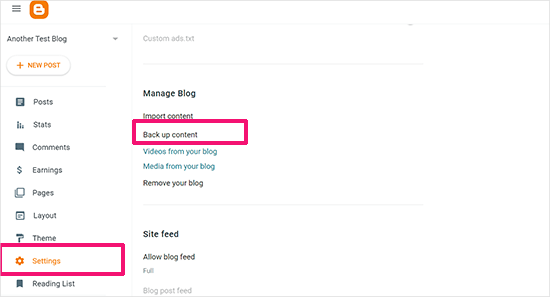
Daraufhin erscheint ein Popup-Fenster, in dem angezeigt wird, was genau in der Blogger-Sicherung enthalten ist.
Um fortzufahren, müssen Sie auf die Schaltfläche „Herunterladen“ klicken.
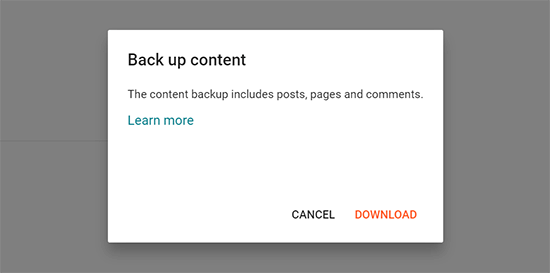
Der Inhalt Ihres Blogger-Blogs wird in einer XML-Datei auf Ihren Computer heruntergeladen.
Sobald der Download abgeschlossen ist, können Sie Ihre Blogger-Inhalte in Ihre WordPress-Website importieren.
Schritt 2: Blogger in WordPress importieren
Um mit dem Import Ihrer Blogger-Site in WordPress zu beginnen, melden Sie sich in Ihrem WordPress-Administrationsbereich an und besuchen Sie Tools “ Importieren.
Klicken Sie auf der Import-Seite auf den Link „Jetzt installieren“ unter Blogger.
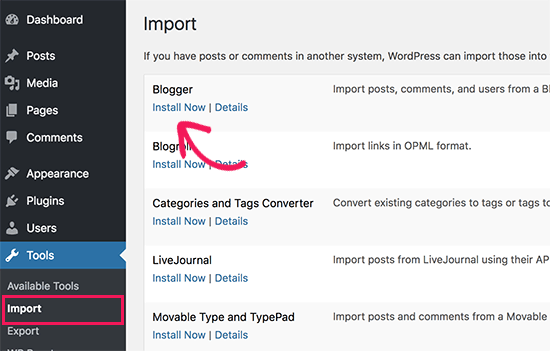
WordPress wird nun das Blogger-Importer-Plugin für Sie herunterladen und installieren.
Sobald die Installation abgeschlossen ist, müssen Sie auf den Link „Importer ausführen“ klicken, um fortzufahren.
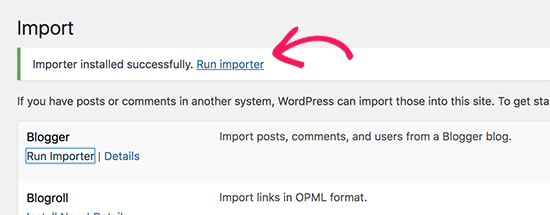
WordPress wird Sie auf dem Bildschirm Blogger importieren auffordern, die XML-Datei hochzuladen. Dies ist die Datei, die Sie in Schritt 1 heruntergeladen haben.
Klicken Sie einfach auf die Schaltfläche „Datei auswählen“ und laden Sie die XML-Datei hoch, die Sie zuvor heruntergeladen haben.
Klicken Sie anschließend auf die Schaltfläche „Datei hochladen und importieren“, um fortzufahren.
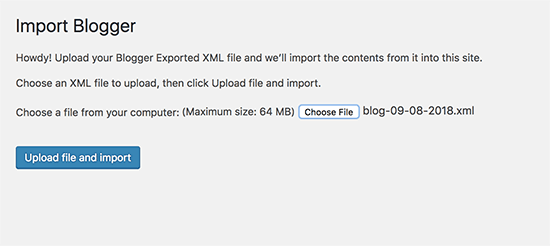
WordPress wird nun die Importdatei hochladen. Wenn Ihre Importdatei zu groß ist, wird möglicherweise eine Fehlermeldung angezeigt.
In diesem Fall müssen Sie die Höchstgrenze für den Datei-Upload erhöhen. Wenn Ihre Datei klein ist, werden Sie keine Fehler sehen.
Als Nächstes werden Sie aufgefordert, Beiträge einem Autor zuzuweisen. Wenn Sie mehrere Autoren in Ihrem Blogger-Blog haben, können Sie für jeden Autor ein neues Benutzerkonto erstellen. Sie können diese Beiträge auch bestehenden Autoren auf Ihrer WordPress-Website zuweisen.
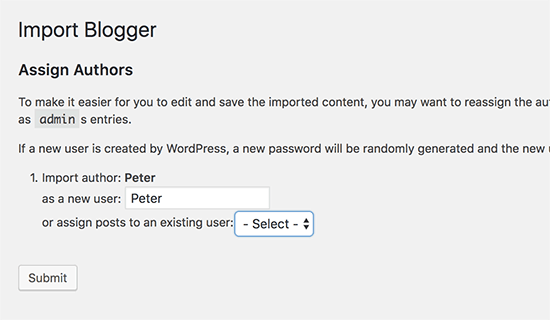
Nachdem Sie Ihre Auswahl getroffen haben, klicken Sie auf die Schaltfläche „Senden“, um fortzufahren.
WordPress importiert alle Inhalte aus der Blogger-Exportdatei in Ihre WordPress-Website. Sie können den Inhalt auf der Seite Beiträge “ Alle Beiträge einsehen.
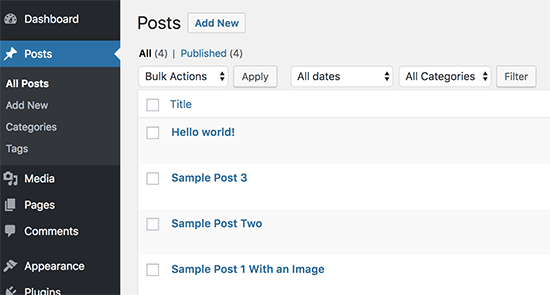
Schritt 3: Permalinks einrichten
Permalinks ist der Begriff für die URL-Struktur der einzelnen Seiten. WordPress verfügt über eine Funktion, mit der Sie eine SEO-freundliche URL-Struktur einrichten können.
Da Sie Inhalte von Blogger importieren, muss Ihre URL-Struktur der URL-Struktur Ihrer alten Blogger-Site so nahe wie möglich kommen.
Um Permalinks zu setzen, müssen Sie in Ihrem WordPress-Dashboard zu Einstellungen “ Permalinks gehen und die Option „Benutzerdefinierte Struktur“ wählen.
Danach müssen Sie den folgenden Text in das Feld neben dem Feld für die benutzerdefinierte Struktur eingeben:
/%year%/%monthnum%/%postname%.html

Mit dieser Permalink-Struktur ähneln die URLs Ihrer Blogposts den URLs in Ihrem alten Blogger-Blog.
Es kann jedoch vorkommen, dass die URL Ihres Blogeintrags, in WordPress auch als Slug bezeichnet, nicht mit den von Blogger verwendeten Slugs übereinstimmt.
Um dies zu beheben, müssen Sie ein kleines Codeschnipsel erstellen und ausführen.
Wir empfehlen, diesen PHP-Code mit dem WPCode-Plugin hinzuzufügen. Das ist der sicherste Weg, um benutzerdefinierten Code zu Ihrer WordPress-Website hinzuzufügen. Weitere Einzelheiten finden Sie in unserer Anleitung zum Kopieren und Einfügen von Codefragmenten in WordPress.
add_action( 'init', 'wpb_update_slug' );
function wpb_update_slug() {
global $wpdb;
$result = $wpdb->get_results("SELECT post_id, meta_value FROM $wpdb->postmeta WHERE meta_key = 'blogger_permalink' ");
$wpdb->print_error();
foreach ($result as $row){
$slug = explode("/",$row->meta_value);
$slug = explode(".",$slug[3]);
$wpdb->query("UPDATE $wpdb->posts SET post_name ='$slug[0]' WHERE ID = '$row->post_id' ");
}
echo "DONE";
}
Nachdem Sie den Code gespeichert haben, brauchen Sie nur eine beliebige Seite auf Ihrer WordPress-Website zu besuchen, um dieses Skript auszulösen.
Wichtig: Vergessen Sie nicht, das Skript nach seiner Ausführung zu deaktivieren oder aus Ihrer WPCode-Bibliothek zu löschen, da es nur einmal ausgeführt werden muss.
Kostenloses Bonusangebot: Sie wollen sich nicht mit Codes herumschlagen? Wir haben ein Angebot für Sie. Da viele von Ihnen danach gefragt haben, bieten wir jetzt einen kostenlosen Migrationsdienst von Blogger zu WordPress als Teil unseres kostenlosen WordPress-Blog-Einrichtungsdienstes an.
Das bedeutet, dass einer unserer Experten die gesamte Migration für Sie übernimmt (100% kostenlos). Ja, Sie können buchstäblich ohne jedes Risiko von Blogger zu WordPress wechseln.
Schritt 4: Umleitungen von Blogger zu WordPress einrichten
Der wichtigste Schritt beim Umzug einer Website ist die Einrichtung einer korrekten Umleitung, damit Sie keinen bestehenden Traffic oder SEO-Rankings verlieren. Weitere Details finden Sie in unserer ultimativen WordPress SEO-Migrations-Checkliste.
Hinweis: Wenn Ihr Blogger-Blog eine eigene benutzerdefinierte Domain anstelle von blogspot.com hat, müssen Sie möglicherweise die Nameserver Ihrer Domain auf Ihren Hosting-Provider verweisen. Anweisungen dazu finden Sie in unserer Anleitung zum Wechsel von Blogger-Blogs mit eigener Domain zu WordPress.
Entscheidend bei der Weiterleitung ist, dass Ihre Nutzer auf der neuen Domain auf der gleichen Seite landen, die sie auf der alten Site aufgerufen haben.
Gleichzeitig müssen Sie dafür sorgen, dass die Suchmaschinen verstehen, dass Ihre Website an diesen neuen Ort verlegt wurde.
Dazu müssen Sie das Plugin für die Umleitung von Blogger zu WordPress installieren und aktivieren. Weitere Details finden Sie in unserer Schritt-für-Schritt-Anleitung zur Installation eines WordPress-Plugins.
Nach der Aktivierung müssen Sie die Seite Tools “ Blogger to WordPress Redirection besuchen und auf die Schaltfläche „Start Configuration“ klicken.
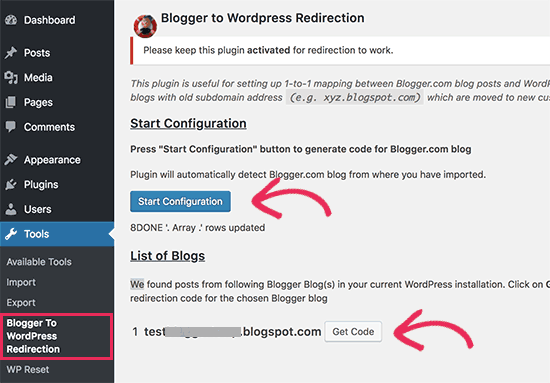
Das Plugin erkennt nun die URL Ihres Blogger-Blogs und zeigt Ihnen die Option an, einen Umleitungscode zu erhalten. Klicken Sie auf die Schaltfläche „Code abrufen“ neben Ihrer Blogger-URL.
Es wird nun ein Codeschnipsel generiert, den Sie benötigen, um Benutzer von Ihrem alten Blogger-Blog auf Ihre neue WordPress-Website umzuleiten.
Als Nächstes müssen Sie sich in Ihrem Blogger-Dashboard anmelden und die Seite „Themen“ aufrufen. Klicken Sie auf den Dropdown-Pfeil auf der Schaltfläche „Anpassen“ neben Ihrem Thema, und wählen Sie dann die Option „HTML bearbeiten“.
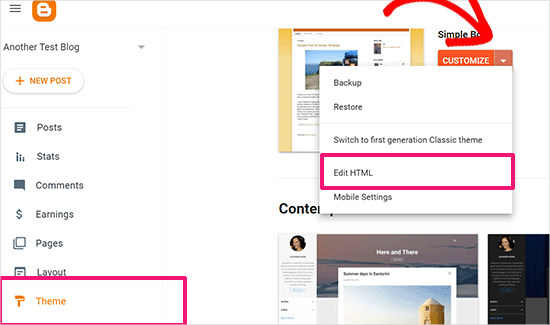
Blogger zeigt nun den benutzerdefinierten HTML-Code für Ihre Themenvorlage an. Wenn Sie Anpassungen an Ihrem Blogger-Theme vorgenommen haben, sollten Sie den Code kopieren und auf Ihrem Computer als Backup speichern.
Andernfalls können Sie einfach alles löschen. Kopieren Sie anschließend den vom Plugin angezeigten Code auf Ihrer WordPress-Website und fügen Sie ihn in den Editor Ihres Blogger-Themas ein.
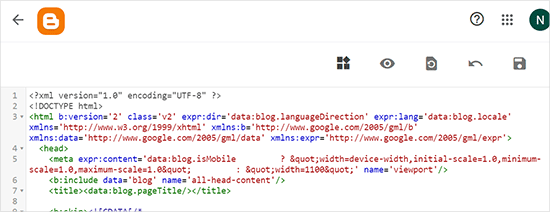
Vergessen Sie nicht, auf die Schaltfläche „Thema speichern“ zu klicken, um Ihre Änderungen zu speichern.
Als Nächstes müssen wir Umleitungen für mobile Benutzer einrichten.
Gehen Sie im Dashboard Ihres Blogger-Blogs zurück zur Seite „Themen“. Diesmal müssen Sie auf die Zahnrad-Schaltfläche unterhalb der mobilen Vorschau Ihres Blogs klicken.
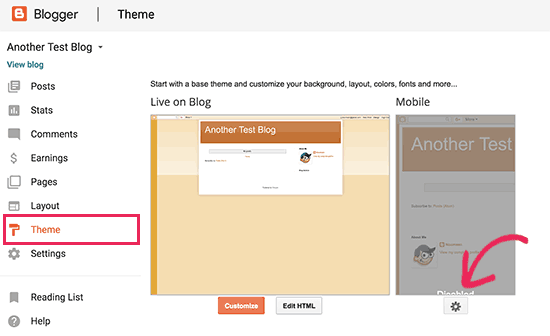
Daraufhin wird ein Popup-Fenster angezeigt, in dem Sie die Option „Nein. Desktop-Thema auf mobilen Geräten anzeigen“ auswählen müssen.
Klicken Sie dann auf die Schaltfläche „Speichern“.
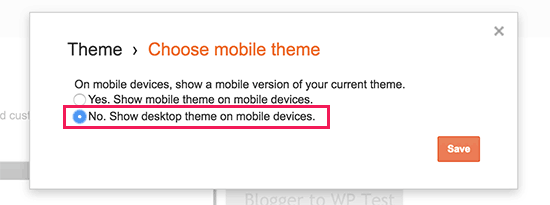
Das war’s. Ihr Blogger-Blog leitet nun alle Besucher Ihres Blogs auf Ihr neues WordPress-Blog um.
Alternativ können Sie auch All in One SEO (AIOSEO) verwenden, um Beiträge und Seiten von Blogger zu WordPress umzuleiten. Das Plugin bietet eine leistungsstarke Funktion für den Weiterleitungsmanager, mit der Sie vollständige Weiterleitungen zu Ihrer neuen Website einrichten können.
Außerdem können Sie die Verfolgung von 404-Fehlern aktivieren und alle defekten Links aufspüren, die bei der Umstellung Ihrer Website auf WordPress auftreten können. Dadurch wird die Benutzerfreundlichkeit verbessert, und Sie verlieren keine Keyword-Rankings.
Schritt 5: Verschieben anderer Inhalte von Blogger zu WordPress
In diesem Schritt werden wir die restlichen Inhalte aus dem alten Blog auf Blogger in Ihren neuen WordPress-Blog verschieben. Dies kann je nach den Einstellungen/Inhalten Ihres Blogs etwas manuelle Arbeit erfordern.
1. Verschieben von Seiten von Blogger zu WordPress
Das Blogger-Import-Tool von WordPress importiert nur Blogger-Beiträge und ignoriert Seiten.
Um Ihre Seiten in WordPress zu übertragen, müssen Sie jede Seite in Ihrem Blogger-Blog bearbeiten, ihren Inhalt kopieren und dann manuell eine Seite in WordPress erstellen.
Um mehr über Seiten zu erfahren, lesen Sie unseren Artikel über den Unterschied zwischen Posts und Seiten in WordPress.
Nun werden Sie auf ein weiteres Problem stoßen. Die Blogger-Seiten haben URLs, die wie folgt aussehen:
http://example.blogspot.com/p/about-us.html
Die URL Ihrer WordPress-Seite sieht dann so aus:
http://example.com/about-us
Um dies zu beheben, müssen Sie das All in One SEO (AIOSEO) Plugin verwenden. Eine Anleitung dazu finden Sie in unserem Leitfaden für Einsteiger zum Erstellen von Weiterleitungen in WordPress.
2. Widgets
Wie Blogger verwenden auch einige WordPress-Themes Widgets, um Inhalte in die Seitenleiste Ihres Blogs einzufügen.
Um Widgets hinzuzufügen, müssen Sie die Seite Erscheinungsbild “ Widgets in Ihrem WordPress-Dashboard aufrufen und Widgets einfach per Drag & Drop in die Seitenleisten ziehen. Ausführliche Anweisungen finden Sie in unserem Leitfaden zum Hinzufügen und Verwenden von Widgets in WordPress.
Wenn Sie ein bestimmtes Widget suchen, das nicht standardmäßig in WordPress enthalten ist, dann benötigen Sie wahrscheinlich ein WordPress-Plugin. Sie können WPBeginners beste WordPress-Plugin-Kategorie durchsuchen, um die gewünschte Funktionalität zu finden.
3. RSS-Feeds
Suchmaschinen und Nutzer, die Ihre Blog-Beiträge über RSS-Feeds abonnieren, können Ihr Blog weiterhin finden. Sie werden jedoch keine neuen Inhalte erhalten.
Um dies zu beheben, besuchen Sie die Seite Einstellungen in Ihrem Blogger-Konto. Scrollen Sie dann nach unten zum Abschnitt „Site-Feed“ und klicken Sie auf „Post-Feed-Redirect-URL“.
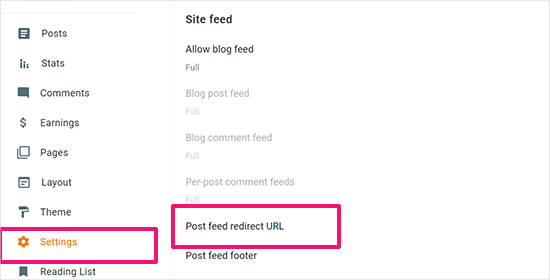
Daraufhin wird ein Popup-Fenster angezeigt, in das Sie die URL des RSS-Feeds Ihrer WordPress-Website eingeben müssen.
Die URL Ihres WordPress-Feeds sieht dann so aus:
http://example.com/feed
Vergessen Sie nicht, example.com durch Ihren eigenen Domänennamen zu ersetzen.
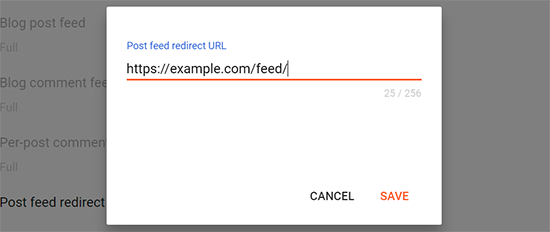
Klicken Sie auf die Schaltfläche „Speichern“, um die URL hinzuzufügen und Ihre Einstellungen zu speichern.
Schritt 6. Was Sie nach der Migration von Blogger zu WordPress tun sollten
Nachdem Sie Ihren Blogger-Blog nun erfolgreich nach WordPress verschoben haben, wollen wir uns ansehen, was Sie noch tun können, um Ihren Blog zu verbessern.
Wir haben eine Checkliste mit den wichtigsten Dingen erstellt, die Sie nach der Installation von WordPress erledigen müssen.
WordPress ist recht einfach zu bedienen. Dennoch werden Sie gelegentlich neue Dinge entdecken, bei denen Sie vielleicht Hilfe benötigen. An dieser Stelle kommt WPBeginner ins Spiel.
WPBeginner ist die größte kostenlose WordPress-Ressourcen-Website der Welt. Wir veröffentlichen regelmäßig Tutorials und Anleitungen, die speziell für Blogger und kleine Unternehmen geschrieben wurden.
Hier sind einige der nützlichen Ressourcen, die Sie auf WPBeginner finden werden (alle sind kostenlos):
- WPBeginner Blog – Der zentrale Ort für alle unsere WordPress-Tutorials und -Anleitungen.
- WPBeginner Dictionary – Unser WordPress-Glossar ist der beste Ort, um sich mit dem WordPress-Jargon vertraut zu machen
- WPBeginner Videos – Neue WordPress-Nutzer können mit diesen Schritt-für-Schritt-Videos beginnen, WordPress zu beherrschen.
- WPBeginner auf YouTube – Brauchen Sie mehr Videoanleitungen? Abonnieren Sie unseren YouTube-Kanal mit mehr als 291.000 Abonnenten und über 50 Millionen Aufrufen.
- WPBeginner Blueprint – Sehen Sie sich die Plugins, Tools und Dienstleistungen an, die wir auf WPBeginner verwenden.
- WPBeginner Deals – Exklusive Rabatte auf WordPress Produkte und Dienstleistungen für WPBeginner Nutzer.
Wir hoffen, dass dieser Artikel Ihnen geholfen hat, von Blogger zu WordPress zu wechseln, ohne Ihre Google-Suchergebnisse zu beeinträchtigen. Vielleicht interessiert Sie auch unser Leitfaden, welchen WordPress-Plan Sie verwenden sollten, oder die häufigsten WordPress-Mythen, die entlarvt wurden.
Wenn Ihnen dieser Artikel gefallen hat, dann abonnieren Sie bitte unseren YouTube-Kanal für WordPress-Videotutorials. Sie können uns auch auf Twitter und Facebook finden.




Syed Balkhi
Hey WPBeginner readers,
Did you know you can win exciting prizes by commenting on WPBeginner?
Every month, our top blog commenters will win HUGE rewards, including premium WordPress plugin licenses and cash prizes.
You can get more details about the contest from here.
Start sharing your thoughts below to stand a chance to win!
Nathan
If you do the swap from Blogger to self-hosted, are the existing pageviews being transferred over to the new website – or will you have to start from 0 all over again?
Stephan
Verz good this article but I have some problems.
I have AdSense on my website and as I have seen AdSense code and Google Analytics code were not imported from the blogger posts in the wordpress posts. What should I do? To edit again all the posts I have and add those two codes?
During the conversion of blogger to wordpress posts AdSense code and google analytics code are not taken?
WPBeginner Support
Hi Stephan,
Google Analytics works on domain names, so you will need to add a new Google Analytics profile to keep tracking traffic on your new WordPress site.
As for AdSense, Blogger accounts usually have hosted AdSense accounts. You will need to upgrade your AdSense account. Simply login to your AdSense dashboard and then go to My Ads and click on Other Products, click Upgrade now and complete the application form.
You will need to regenerate AdSense ads code and add them to your new WordPress site. See our guide on how to properly add Google AdSense in WordPress.
Admin
devendra
Now anyone visiting a post on your old Blogger blog will be redirected to the same post on your new WordPress site. ……
What is mean by this……..redirect on a single post only.
Petra
One question – when I move my content to WordPress, do I delete my old blog in Blogger or not? Some say yes cause Google doesn’t like the same content on both pages (something like that), some say no cause all your pics are going to be deleted… I’m confused.. Do redirections even have sense if you delete your old blog? Confused again. Thank you for your answer! ☺
Khaliff Mogaji
Hi,
I have followed the instructions step by step but my blogger blog redirects to the homepage of my wordpress blog instead of it to redirect to the exact post on the wordpress site.
Min-Chi Hsieh
Hi,
Really appreciate for this article… But, I have one question needs your help…
I moved my blog to wordpress one year before and everything was good… But, when I changed the theme, I edited my functions.php as last time, it showed undefined index, pointed to this line „$blogger = $wp_query->query_vars[‚blogger‘];“
Do you have any suggestion? Thanks~!!
WPBeginner Support
Hi Min-Chi Hsieh,
You can copy the redirect code from your old theme’s functions file and paste it in new theme.
Admin
Min-Chi Hsieh
Hi,
I did it… And it still showed the same note… Any suggestion?
Pengedar Shaklee Farha IbuCergas
hi, the function.php need to be added everytime we change the theme right? because every time i change the theme, it is gone.
WPBeginner Support
Hi Pengedar,
Yes, you will need to paste it in your active theme. If you will be switching themes a lot, then it would be best to create a site-specific plugin and then paste the code inside it.
Admin
Rajat Shankhdhar
Is it really necessary to set permalinks as moth/date in 301 redirect or it’s just looking the post same like in blogger
bethan arundel
Hi, I have an issue that when I go onto my blog spot now after following the steps it just has a big link in the middle of the page that when you click on it it goes to my new wordpress site, but it doesn’t automatically direct. Help would be much appreciated.
Hamid
I wanted to leave my site on .blogspot.com but i discovered some of the interlinks on my blogger blog are not redirecting to the right post on WordPress
Benny
I too encountered this problem.
What I did was I changed the permalink to custom and add
“ /%year%/%monthnum%/%postname%.html
“
without quotes
Hope this helps!
Christine
Benny,
THANK YOU SOOOOOOOO MUCH for leaving this comment! I just went through the process on converting over from Blogger and ran into this very issue. I was wondering how the .html translated automatically over to wordpress and realized they didn’t at all! My links posts weren’t re-directing and now they are thanks to you!
Christine
Elisabeth Anggia
Hi dear,
Thank you so much. It works for me.
I keep coming to this place, because your tutorial is easy to follow even for a beginner like me.
Mariusz
Hi. Thanks for your tutorial.
Something strange happened to my blog. When I look on mobile version I see all posts from blogger. but on desktop version some posts are hidden. How can make them visible – can you help me? In WP admin I cannot see it as well…
Marianne
Hello! Thanks for the great tutorial. I set up the redirects and I think there is an issue with it redirecting to the www. vs without www. Do you know how to fix this?
Heather
I am having the same issue, have you found a way to fix this?
Lori
I’m going to use a theme on my wordpress site – do I integrate that before or after I transfer blogger site over.
WPBeginner Support
Hi Lori,
You can do that later. This will give you a clear idea of how your content looks when its imported and how you’d like to set it up.
Admin
udayvir singh
Thanks for great tutorial.
I have done almost all the job, but there s a problem, My all blogger posts are perfectly redirecting on proper WordPress url but blogger pages urls (www.example/p/pageurl/) are not not redirecting to right path (www.example/pageurl/).
Please help me..if there is any way to deal with the issue.
WPBeginner Support
Hi Udayvir,
Please take a look at our guide on how to setup redirects in WordPress.
Admin
Sin Yee
This article helps much! Have successfully migrate everything to the new hosting. Did the redirect too! Thank you so much!
abu sufian
I try to uplaod. xml file but after uploading its said all done! have a nice day! and redirected to my admin page. don’t ask author name. what can i do??
WPBeginner Support
You can also change author name manually. Go to Posts and click on the Screen Options button at the top. Select the number of posts you want to display on the page. You can display upto 999 posts at a time. After that click on the Check All checkbox to select all posts displayed on the page. Next, select Quick Edit option from the Bulk Actions drop down menu. This will show you a box where you can change the author name.
Admin
Anindra
Here is what I have:
Blog #1:
1. Hosted on hostgator.com
2. Custom domain registered through hostgator
3. Still active, but I’ve almost abandoned it
Blog #2:
1. Hosted on Blogger
2. Custom domain registered through blogger
3. Still active and I’m using it
I want to replace Blog #1 with Blog #2.
Questions:
1. Is it doable?
2. How?
WPBeginner Support
Hi Anindra,
Yes, it is doable. See the instructions in the article above.
Admin
Sharoon Qadeer
I have tried this but this not redirecting post. All links are redirected to homepage.
Adding code in functions.php shows a code in header and adding code in site-specific plugin it doesn’t work and neither doesn’t redirect to post
Steph
In your Permalink settings paste this code on the custom structure
/%year%/%monthnum%/%postname%.html
Jui Deb
Hello, If i migrate mu blog from blogger to WordPress than will it be copy paste for google?? As i will use same content in my blogger and WordPress blog if i migrate it from blogger to WordPress?
Dina
Hi,
Just wondering if this process will work if I’m transferring from a .blogspot.com to a .wordpress.com site. Not planning on self hosting just yet, but plan to in the future so I figure it’d be easier to switch to wordpress now.
Does this still work?
Dhiraj Kr Yadav
Hi its really helpfull video.I do have a question kindly help me out.I do have a blogger account and its verified from google now i created a blog on wordpress with same same but when i tried to verify my site by google its telling i cant verify it as i do have a blogspot account.kindly help me out.How can i verify my site from google.Kindly guide me and help me out.
with regards.
Dedrick Jordan
If you did not the video, it some pretty simple steps to take, just watch the video, and it shows you what u need to do, and you should be using WordPress.org big difference.
Rahul
Hi WP
Thanks for this informative post. I want to move my blogger custom domain blog to wordpress. I had purchased my domain name from GoDaddy and linked it with blogger after reading some tutorials. Can I follow the exact procedure in this post or there are some changes given that I use a custom domain name? Pls reply! Thanks
Chuks Amobi
Blogger images always have a long string of characters instead of the original image name. My question is, will the images be exported to WP with the same long string image name or the original image name?
Hans ganteng
Hi nice share guy, btw I have one question. Is it possible setting permalink on wordpress same with blogger So I dont need set redirect 301?
Example on WP blabla com/%month%/%date%/%postname%.html, I mean replacing slash (/) to .html ?
Thank you
Ernest
I like this tutorial and I am reading it with keen interest because I have a blogger site that is running on the blogger URL. Please I want to know if I can do the transfer with that URL or the site must be on custom domain, as recommended by other writers.
Lauren Alyce
Thanks for the information, it was very helpful. Just converted my blogger to WordPress today. I used a plugin that helped me generate the code for my blogger template called Blogger to WordPress so I didn’t have to make any changes to my themes function files on my own. This could be an option for the people that are getting errors.
Ernest
Dear Lauern, I think your comment makes sense to me since WPbeginner have not responded to my inquiry I decide to ask you this; can I do the migration with my blogger.com domain, or do I need a custom domain or my blogger site before going for the migration?
Please, anyone can respond to this question.
WPBeginner Support
Hi Ernest,
If you have a domain name like myblog.blogspot.com, then you can transfer your blog but not the domain name.
On the other hand if your blogger blog have a custom domain like example.com, then you can use that domain on your self-hosted WordPress.org site aswell.
Admin
Dedrick Jordan
I did watch the tutorial you would, have to buy a domain, when you are purchasing a self hosting for wp. But the domain is entirely free, on the other name the self hosting page is really cheap. So that means you could get a whole entire year for less then $60 dollars my man.. Hope the feedback helps
Poorna
Hi,
Thanks for the nice tutorial. Unfortunately, i had moved from blogger to WP before seeing this tutorial. The result is the formatting of content in old posts in blogger and pictures after migration has gone haywire. Is there anything that can be done to make it look good now? Your answer will be very helpful. Thanks in advance.
Emmanuel
I will really love if you fix the code we need to post in blogger because it showing some errors which make it not to save..
Hannah
This article and video is brilliant- thank you so much!
Quick questions, you mention in the video if you choose a new theme, you have to do that specific step again. If I purchase a new wordpress theme and install that, do I need to repeat that step? Or is that step only to be repeated if you change the blogger theme?
Thanks in advance,
Hannah
WPBeginner Support
Hi Hannah,
Glad you found the article helpful.
As for theme changes. If you add any code to WordPress theme files, then you need to save those changes elsewhere as well. If you update your theme or install a new theme then you can copy and paste to add that code to your new WordPress theme.
Admin
Elise
Hello,
I have followed the instructions above to transfer my blog to Bluehost as above, but now want to return to my old blog until I am ready to devote time to working on the WordPress site.
How do I return to my old blog (which is now showing an error message?)
Thank you in advance,
Elise
WPBeginner Support
Hey Elise,
Simply login to your Blogger account and then switch your blogger theme from classic to any newer theme. This will restore your Blogger blog.
Admin
Elise
Brilliant, worked a charm. Thank you!
Carolyn
This is a great tutorial, but I have a couple of questions I hope you can help me with.
I have a blogger blog with it’s own domain name that I bought through Go Daddy.
I want to migrate to WordPress, but I want to do it with a different domain name hosted by Bluehost.
Is there a way to do this without losing google rankings/pinterest links, etc?
WPBeginner Support
Hey Carolyn,
We will recommend you to first move your blog to the old domain name. You can point that domain to Bluehost as well.
Once you have moved your blog to the new location and everything is working fine, then you can easily setup permenant redirects. See our guide on how to how to move WordPress to a new domain without losing SEO
Admin
Carolyn
Thanks for your fast response! I want to make sure I understand your advice.
So as of now, my old blogger blog is still connected to my old domain name on Go Daddy.
And now I have a new domain name on bluehost with a theme set up. But I haven’t migrated any posts over.
Can I let my old domain name expire and not lose SEO?
What do I do next?
WPBeginner Support
Hi Carolyn,
You need to keep your old domain for as long as possible. After few months if you are satisfied that all your traffic is back to normal then you can let the old domain expire. However, keep in mind that anyone can then take over that domain name and they can copy your old content and start outranking your new domain name.
Cindy
Most of my old posts from blogger have a different address in wordpress. When I put in the page redirect code, it not only doesn’t redirect to the right page, but it goes to a Go Daddy page!! I DESPISE Go Daddy, so this is the worst of all worlds.
How do I add coding to the 2nd part of step 4 above to make pages with mismatched addresses just bounce to the homepage of the new blog?
I tried to just undo the page direct and leave it with the general redirect, but I’m still getting the Go Daddy page instead.
WPBeginner Support
Hi Cindy,
Seems like your domain is not properly setup yet. Domain name server changes take some time to propagate. Check your domain name settings to make sure that it is pointing to your WordPress hosting provider’s nameservers.
Admin
Cindy
It’s not a propagation issue. I’ve been using this domain for several years and I have NEVER done business with Go Daddy.
I undid all the site and page redirects and added a couple by hand. That’s not a realistic option though.
As I said, the redirect code recommended here fails because the post names don’t match between blogger and WordPress. (WP mangled the names when I did the import two years ago.) That would be ok if the ones that don’t match would redirect to my WP homepage. Instead it tries to redirect the ones it can’t match up to the myblogname.com portion of the blogger address. I don’t use that name on WP because someone has been sitting on the regular URL for years. (I assume Go Daddy captures the page because the squatted address is registered through them. )
I just need code added to the redirect that tells the net „if you can’t find this post address, go to this page (my WP homepage) instead.“
Lynwood Thorson
Pretty! This has been an incredibly wonderful article. Many thanks for providing this info.
Ashutosh
Hi,
Thanks for the nice and detailed tutorial. I have a question on permalink part.
Blogger urls are like domain/year/month/postname and after migration I hope it will be same.
But what about the new post i will publish on WP? their URL will be also same or I can make like domain/postname?
please assist.
WPBeginner Support
Hey Ashutosh,
Your new posts will use the same URL structure you selected in Step 3 of the article. It will be the same you used on Blogger.
Admin
Maria Skatova
Hi, I am planning to move my blog from Blogger to WordPress and not sure how the migration works with images – does it import original photos from Blogger to WP media library and put them into year/month folders (as WordPress itself does)? Does it mark the photos as ‚attached‘ to according posts?
Thank you very muck in advance
Vanita Sosa
Great blog! Do you have any suggestions for aspiring writers? I’m hoping to start my own website soon but I’m a little lost on everything. Would you suggest starting with a free platform like WordPress or go for a paid option? There are so many options out there that I’m completely overwhelmed .. Any tips? Thank you!
WPBeginner Support
Hey Vanita,
We will recommend you to start with a self-hosted WordPress.org site. See our guide on how to start a WordPress blog for complete instructions.
Admin
Kimberly Dsouza
Hi,
I followed your tutorial and redirected my blogger (custom domain) blog to a new domain on WP and everything works fine.
However, when I tried the „change in address tool“ in google webmaster, it says
„We couldn’t find any 301-redirect directives for your site“
The „fetch“ data shows a „200 OK“ response instead of 301 Moved Permanently!
So, how do i correctly do a 301 redirect?!
Lizet
I used your instructions to migrate my blog. I´ve been having so many problem (because I´m very ignorant on all this) and would like to start over again. Is there a way to restorer back my blog on blogger? I´ve call different companies in the country where I live to see if they can fix whatever the problem is with my blog on wordpress, but they don´t want to help me. So I thought if I can restorer my blogger, maybe they can do all the process from the beginning. Thanks for your help!
WPBeginner Support
Hey Lizet,
To restore your blogger blog. Login to the Blogger dashboard and then go to Theme section. Select an apply a new theme and your Blogger blog will be restored.
Admin
Andrea Restrepo
Hello.
I did redirect my blog and it is redirecting with no problems in a pc version but still going to the old blog in my android phone.
Could you please tell me if I need other code??
Sajid Khan
Hey Andrea,
You don’t need any other code just goto your blogger dashboard and then goto theme section. Goto mobile and click on no, show desktop version.
Kazumi
Thank you so much!
I had the same issue with mobile redirection too.
It was so easy but I couldn’t find out the solution!
Nicci
Thank you so much!!!!!!!!!!!!!!!
I used Code Snippets to add code in the functions php file (since I was a bit nervous to try myself) and it works!! Thank you!
tara
I tried to migrate my blogger blog to wordpress and I get this error once trying to import the file:
warning: reset() expects parameter 1 to be array, boolean given in /home2/susanpad/public_html/wp-content/plugins/blogger-importer/blogger-importer.php on line 696
I tried also to use blogger import extended plugin but it duplicates content and images are blurry. Also it doesn’t carry over the read more section.
Help!
Myle
Thanks for your reply. Seem to be getting some problem with importing Blogger posts into WordPress. I have all the plugins installed on Blogger and Blogger Importer Extended. When I click on Tools–>Import –>Blogger–>Run Importer and go through the steps, then press import but it just shows a blank page with the word „Import“ in the end. Then when I reload, it says „File is empty. Please upload something more substantial…“ Tried a few times with different tweaks but still the same. Could it be the theme or anything wrong with my WordPress ? Anywhere that will show how to solve this issue ?
Nwachukwu
@Myle try backing it up again from your blogger blog, make sure the file is also in the right format.
shahbaz khan
thanks for sharing such a good content.
If i write post after swith from blogger to wordpress then i will post on Blogger or wordpress?
my blogger site will close?
WPBeginner Support
Hi Shahbaz,
No, your Blogger site will still be there but will not be visible to users. You can still login to your Blogger account and see your content.
After you have switched you will post content on your new WordPress site.
Admin
Myle
Once I have imported my blog from Blogger to WordPress, can I still create blog posts from Blogger and will it automatically reflect the latest posts in WordPress ? Or from then onwards, I can only create new blog posts in WordPress ?
WPBeginner Support
No, your blogger blog posts will not be synced to your new WordPress site.
Admin
Navin Rao
This was the best post on migrating from Blogger To WordPress including the video tutorial…
Thanks for sharing… it helped
Navin Rao
chen
The most useful post i’ve read recentlay
Rob
Thanks! This is really helpful and much appreciated. I have subscribed to your youtube channel. Keep up the good work
Srikanth Eswaran
One query, does this article apply if my new domain name is the same one as what was pointing to Blogger earlier? for example if I had 123 dot com pointing to a blogger account, and I set up wordpress to also have the domain 123 dot com, would this redirect now work?
Please let me know.
Prashant
I’ve deleted all posts after running blogger imported, Now it’s not importing anything.